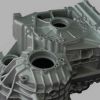Group Info
Pay Attention To Product Evaluation Of Mold Release Agent
Before evaluating any new or replacement Mold release agent , the production benchmark should be determined and the number of cycles that can be achieved before the release agent is reapplied. For example, if you want to spray every sixth time on Part X, check if you can spray every seventh or eighth time. Each additional cycle without spraying can save a lot of money.
When choosing an agent to eliminate cycle time reduction issues, follow some important steps below.
Use the most difficult part to test. If it looks good, try it on other parts molded from multiple resins.
Eliminate debris. Make sure to clean the mold thoroughly and remove all traces of old release agent. Cleaning the mold before each test helps to ensure that the test results are accurate and reflect the performance of the specific release agent.
Consistently. Ensure that the molding conditions will not change during the trial period. It is best to set up and evaluate all mold release properties during one stamping operation, because each operator has his own working style and style, just like molding machines and molds. This will affect the performance and molding results of the release agent.
Test to see how many parts can be released with the current mold version and settings. Then clean the mold to ensure a fresh molding environment. Apply the new test release agent according to the instructions, then run the mold until the part starts to hang and you need to apply the test release agent again. Repeat this process several times to ensure that a large number of test results are obtained for comparison to ensure consistency. Try to ensure that the only factor that changes is demoulding. The same operator, resin, mold temperature and pressure are used, so these factors will not affect the results.
Use the whole can. After selecting the most effective release agent, test with a full tank and record the number of molded parts. As more demolding products are used on the mold cavity, the demolding performance may change in both positive and negative directions. Using too much release agent will cause the surface of the mold to accumulate and adversely affect the release of the part; too much release agent will cause premature adhesion of the part.
Determine the cost-effectiveness of release. Calculate the cost of each part by dividing the number of parts of the mold release product A by the cost per tank. The demoulded product B is then used for this calculation. This will provide an accurate measure of the cost of each demolded part to purchase the release agent. Generally, more expensive release agent tanks can provide greater performance in the number of released parts, so that when more expensive but better performance release agents are used, the cost of each released part can be much lower.
Choose according to productivity. It is important not to evaluate products based solely on product prices. A more important indicator is the number of parts that the product can release. What is really interesting is the amount of money spent on release and the maximum number of parts that can be molded. Now that the release assessment can determine the key facts, you can calculate the most appropriate release for a particular resin and part.
Alkyl alkyl polysiloxane is the core raw material of die-casting
water-based release agent. It provides excellent heat resistance for the release
agent formulation and can maintain the function of the formulation during the
die casting process. Silway provides mold release agents and finished product
raw materials mold release agent manufacturers, and is also a professional
supplier of agricultural adjuvant . The agricultural
industry provides various solutions, including: silicone additives, silicone
defoamers, water retention agents, methylated seed oil surfactants. Welcome to
consult for details: https://www.silways.com/application/mold-release-agent.html
- Created: Aug 3 '20
- Admin: ritchiesilways
Users
Newsfeed
- No items

